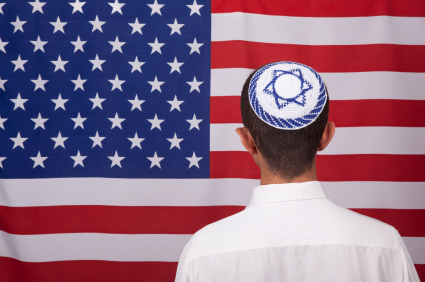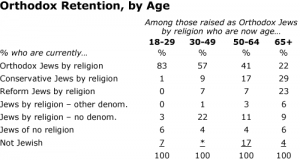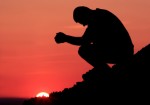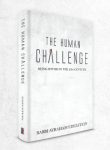
The Pew study found 6.8 million American Jews[1], 25% more than the 2001 National Jewish Population Survey which found 5.2 million[2], but these are self-definitions with widely varying ideas about what it means to be Jewish. 1.3 million children are being raised at least partly Jewish. In a Jewish home in the United States, you’re more likely to find a Christmas tree – 32% — than a kosher kitchen – 22%. Nearly half of American Jews do not know the Hebrew alphabet,[3] and 34% said you could still be Jewish if you believe that Jesus was the Messiah.
Jews make up 2.2% of the American population, a percentage that has held steady for the past two decades.
The Pew results did not provide any radical news on the dismal state of intermarriage and lack of basic Jewish literacy and affiliation. Nor did we need Pew to tell us that the middle is falling out of the Jewish people (Conservative Jews are now only 18%), that the Orthodox, although showing little growth so far, should reflect big increases in the near future (see analysis below), and that the unaffiliated at 30% now comprise American Jewry’s second largest group after Reform at 35%. Ten years ago, 93% of American Jews told surveyors that their religion was Judaism. This year, only 78% of those who were raised as Jews and identify as Jews said that their religion was Judaism. Just 7% of Jews born between 1914 and 1927 say they have no religion; 32% of Jews born since 1980 say they have no religion.
The Conservatives are set to fall further. While 24% of Jews older than 65 identify as Conservative, only 11% of Jews aged 18–29 do the same, and this, from a movement that was the largest in America for most of the 20th Century. Just 36% of Jews brought up Conservative say that they are Conservative today. Most of those lost went to Reform, in particular the intermarrieds. The Reform will also show increasing attrition. Only 29% of people aged 18 to 29 are Reform, giving it an aging population. Only 55% of those brought up Reform are Reform today.
Non-Orthodox birthrates average around 1.7, and that includes births from non-Jewish mothers married to Jewish fathers. The average age of Conservative and Reform adults is now 55 and 54 respectively, and the trend points to these populations aging further with time.
Pew produced, in just one week, tens of articles, Facebook posts and Twitter comments on the current and future state of American Jewry. No journalist likes to be late with his story and, in a world where last year’s iPhone is out of date, the latest study always wins. The Pew study deserves attention, but only as a contrast to the dozens of studies that go on about American Jewry all the time. While it is doubtful whether the study will lead to any significant changes in funding priorities, Pew can be credited with keeping the issues alive, and perhaps energizing the missions and visions of those who know that American Jewry needs a lot of input.
Why the Orthodox stayed static
The results showed a plummeting Conservative (down to 18%), a stable Reform (at 35%), and a growing group of unaffiliated (at 30%). All of that we knew before. But the Orthodox percentage of the population did not go up. It was static at 10%.[4] This was a surprising result. Other studies led to the expectation of a growing Orthodoxy. The Orthodox proportion of American synagogue members has been going up from 11% in 1971 to 16% in 1990 to 21% in 2001, and maybe it went up again now. But with high birthrates (4.1 children per couple compared to 2.2 of the non-Orthodox), quick generational increase (the average Orthodox generation is about 30 years whereas it is about 40 years in the broader population[5]), Baalei Teshuva (150,000 according to Pew[6]) – we should have seen some growth. The study showed 330,000 who left Orthodoxy[7], (or put differently, only 48% of people who were brought up Orthodox remained Orthodox) so that would explain it.
But, this is not as bad as it sounds. The study showed that those who left Orthodoxy are mainly in the older demographic.[8] Just 22% of people 65 and older who were raised Orthodox are still Orthodox, while 57% of people aged 30–49 who were raised Orthodox are still Orthodox. By my calculations, most of those people left Orthodoxy when they were much younger, between 1970 and 2000 (12 years ago, I figured on 300,000 leaving during that period of time), but that should have meant an increase in the Orthodox percentage in the last 12 years, when the population was stabilizing.
Of course that 10% is highly vibrant by any variable: Their educational institutions, birth-rate, or level of commitment.[9] In addition, the Orthodox are no longer an economically deprived group. There is no longer an incentive to leave Orthdoxy in order to climb the socio-economic ladder. “I’m predicting that younger Orthodox will have much higher retention rates,” Stephen M. Cohen[10] said. “Orthodoxy has raised the bar, so today’s version of what it means to be Orthodox is more compelling and cohesive than in previous generations.” (Pew did reveal some disturbing things about the Orthodox though. Only 83% say religion is very important in their lives. 14% do not. And 2% say they do not believe in God.)
But beyond that, in my opinion, the study is underestimating the current number of Orthodox. It is showing 600,000 Orthodox Jews (10%), when really there are closer to a million (about 17% out of 6.6 million). So, how did the study get it wrong? Firstly, the sample was randomized. However, due to the concentration of the Orthodox Jews in particular areas, randomization is likely to skew the results away from the Orthodox. (And so, for example, I cannot find a single Orthodox person who was contacted by the survey.)
In addition, the sample includes many non-halachic Jews, and this increases the sample size and dilutes the Orthodox percentage.
Furthermore, local community studies show a greater increase in the Orthodox population than the Pew study. The population of Orthodox Jews in the New York area grew by more than 100,000 between 2002 and 2011, according to a survey published in 2012 by UJA-Federation of New York.
[I have another proof that the results are off. The study showed that 79,200 of the 150,000 Baalei Teshuva came from the unaffiliated, while only 47,520 came from the Conservatives. Yet, experience has taught us that most Baalei Teshuva came through the Conservative movement.]
It was also pointed out[11] that Jews who attend Chabad and other outreach centers probably were counted wrong. There are 875 Reform synagogues in North America (representing the strongest branch of Judaism) while there are 959 Chabad centers. Jews attending these places often will not define themselves as Orthodox because the definition of Orthodox means fully observant. But really they are Orthodox Mechalalei Shabbat, even though they will be identified as Conservative or Reform. (Such Jews may or may not be official members of a Reform or Conservative community, but their primary attendance will be at the Chabad center.)
In any case, Orthodoxy is showing a vibrancy that should lead to a significant increase over time. Their birthrates are far more than twice those of other Jews, who clock in at 1.7 children per couple (not all of whom are halachically Jewish), below the replacement level of 2.1. The Orthodox age profile is young (as opposed to Conservative and Reform adults (55 and 54, respectively), and their intergenerational retention rates for the younger age groups are very high.
This answers a question I was asked about the study. If, as the study shows, we gained 150,000 Baalei Teshuva and lost 350,000 born-Orthodox, should we not put more money into retention than into Kiruv? Retention now is high, as I stated above. (In any case, only a tiny percentage of money is allocated to kiruv compared to the broader Orthodox world. Here is not the time to spell this out. But, just as an example, Lakewood Yeshiva has an operating budget of $35 million a year and a capital campaign budget of another few million; that equals or exceeds the total amount of non-Chabad outreach projects on all the campuses of North America combined.)
[1] The new population estimates are not based on a new survey. Rather they were synthesized from the data of nearly 350 recent surveys of the U.S. adult population, with more than 320,000 respondents and 6,900 Jewish respondents. Titled “American Jewish Population Estimates: 2012,” the study was conducted by the Steinhardt Social Research Institute and the Cohen Center for Modern Jewish Studies at Brandeis University.
[2] However, because the methodology used was completely different, the newer numbers cannot be used to demonstrate an increase in the U.S. Jewish population.
[3] Only 12% said they could have a conversation in Hebrew, with another 5% volunteering they could “sort of” do so.
[4] The 2001 NJPS study showed the Orthodox at 8%.
[5] I made this calculation based on the average age when the Orthodox and non-Orthodox get married and the average length of marriage until the middle kid is born.
[6] The impact of this number is double because each person is leaving the non-Orthodox population and then joining the Orthodox population.
[7] Here too the impact of this number is double as per the previous note but in the opposite direction.
[9] According to Pew, the majority of Orthodox Jews are ultra-Orthodox. Modern Orthodox Jews make up 3% of America’s Jewish population. Ultra-Orthodox Jews make up 6%, according to Pew.
[10] Steven M. Cohen is a research professor at the Hebrew Union College-Jewish Institute of Religion and director of the Berman Jewish Policy Archive at New York University’s Wagner School of Public Service.
[11] http://www.aishfl.com/purplesheet/.





















Ethan Cohen
Assuming these facts are correct, Orthodoxy has not stayed static. American Jewry grew overall by more than 25%, and the Orthodox share went from 8%-10%, thus beating overall growth by a further 25%. Thus, Orthodox growth over 12 years is about 56%, or about 3.6% annually. If Orthodox Jewry were a country, it would be in the five fastest growing in the world.
Steve Brizel
Many have commented erroneously that kiuv has been a failure despite the sums alloted thereto. I would doubt that any of the kiruv organizations operate on a budget anywhere that of BMG. Despite that fact, such critics fail to understand that kiruv is a person by person, mitzvah by mitzvah process, as opposed to an assembly line.
Micha Berger
There is another factor too. If the population “growth” from NJPS’s 5.2mm to Pew’s 6.8mm is primarily due to difference in definition of who is a Jew to be counted, then few of those new people are Orthodox. In the extreme but quite possible case that the number of newly countable Orthodox Jews is negligible, then Orthodoxy’s climb from 8% to 10% is not 20% growth, but 63% growth. (10% of 6.8mm = 13% of the original 5.2mm, which is 63% greater than 8%.) Saying we grew by more than 50% in ten years is a quite plausible conclusion from a comparison of the two surveys, and it is also quite rapid growth.
But it would also be correspond to an average family size of 5 children who remain Orthodox (assuming 25 year generations), which I think is beyond reality. 6 may be typical in some communities, but given that not everyone can achieve the number of children they planned on, my guess is that the average even in those communities is below that norm. And then substract out the children who leave Orthodoxy.
Micha Berger
There is another factor too. If the population “growth” from NJPS’s 5.2mm to Pew’s 6.8mm is primarily due to difference in definition of who is a Jew to be counted, then few of those new people are Orthodox. In the extreme but quite possible case that the number of newly countable Orthodox Jews is negligible, then Orthodoxy’s climb from 8% to 10% is not 25% growth, but 63% growth. (10% of 6.8mm = 13% of the original 5.2mm, which is 63% greater than 8%.) Saying we grew by more than 50% in ten years is a quite plausible conclusion from a comparison of the two surveys, and it is also quite rapid growth.
But it would also be correspond to an average family size of 5 children who remain Orthodox (assuming 25 year generations), which I think is beyond reality. 6 may be typical in some communities, but given that not everyone can achieve the number of children they planned on, my guess is that the average even in those communities is below that norm. And then substract out the children who leave Orthodoxy.
Yaakov
Nice article, but bad choice of words in this sentence: “There are 875 Reform synagogues in North America (representing the strongest branch of Judaism).” Reform is not Judaism. There is no such thing as branches of Judaism, unless you are talking about different types of halachic Judiasm. There are plenty of non-halachic Jews, but there is no such thing as non-halachic Judaism.